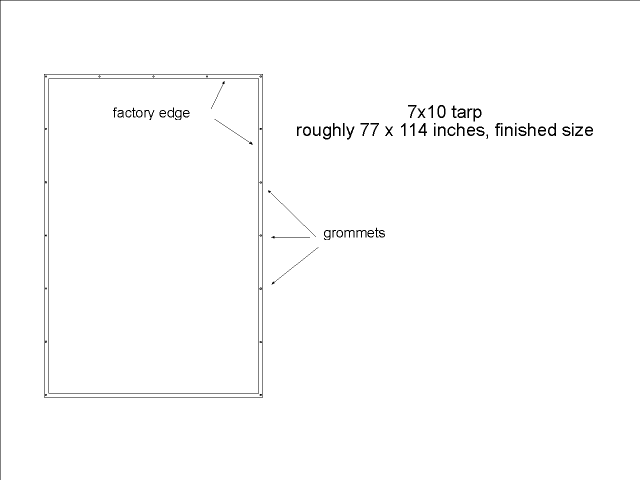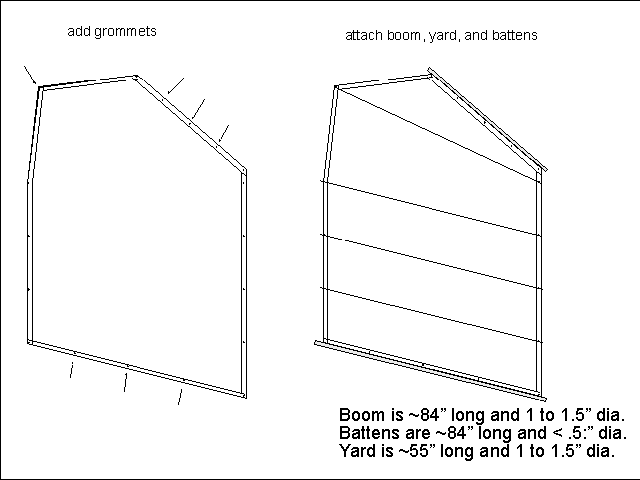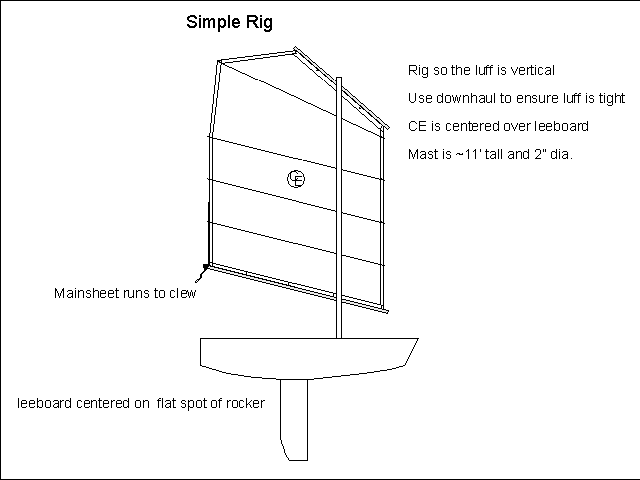
|

I received a 7x10 white polytarp sail from Dave Gray at Polysail, International (http://www.polysail.com) and I had a friend who wanted a Chinese Lug sail that was about 50 square feet in total area. I have been reading 'Build and Design your own Junk Rig' by Derek van Loan and decided to see if I could get a sail similar to that of an ocean-going Chinese junk. What I ended up with is a sail that is sort of a mix between a van Loan sail and the Chinese Lug described in Chris O'Donnel's Cheap Pages
To get the maximum surface area out of the tarp, this design uses the tarp's factory sides for the luff and the leach and the grommets as attachment points for the boom, battens, and yard.
Start by drawing an outline of the finished sail - use a wet erase marker so you can clean off your marks later (I've found wet erase cleans easier than dry.). Use the grommets as landmarks. Make sure your sail outline includes the grommets. Finish by drawing the cut line about 1.5 inches outside the sail outline this will be your hem. Just run the cut line off the edge of the tarp.
Cut along the cut line and fold the hem at the sail outline. You want the hem on the starboard (right) side of the sail. I like to lay a length of 1/8" low/no stretch rope inside the fold to reinforce the edge a bit. I sew the hem down, others use double-sided sticky tape (like carpet tape) and still others use both. For sewing, I use a standard sewing machine with a #16 needle and Upholstery thread or Dual Duty XP Heavy by Coats and Clark. I tighten the resistance on the thread quite a bit (8 on my machine) to keep it from bunching up on the back side. First, I put on a welting foot and run a straight stitch as close as possible to the reinforcing line. The next thing I do is go around the edge of the hem with my machine's widest zig-zag stitch.
I put 3 additional grommets in the head and foot of the sail (for a total of 5.) This way, there is a grommet in the corners, one in the middle, and a grommet centered on each side of the middle. The yard and boom are a little over long so I can pull the sail as tight as possible. I attach the yard and boom with zip ties. I use the same 5-attachment point setup for the battens (at the ends, center, then mid-point between dcenter and ends.) I zip-tie the ends of the batten to the outside grommets, then take a hot nail and poke holes through the sail on either side of the batten in the middle and so on. Zip tie the batten to the sail through the hole.
The sail is roughly 51 square feet in area - plenty to drive a PDR (my first PDR used a similar sail and it went like stink on ice.)
The easiest way to rig the sail is to step the mast so the sail will hang vertically with the Center of Effort (CE) directly over the Center of Lateral Resistance (CLR which is usually the center of your lee/dagger/centerboard on a PDR.) There you have it - a simple, cheap, and excellent sail that uses almost all of your 7x10 tarp and looks freaking great. I love the Chinese Lug as it really grabs people's attention and it works very, very well. There are much more complex ways to rig a Chinese Lug (like having sheetlets pair the battens together, then a block for each sheetlet all running down to blocks on a boomkin and a single mainsheet to control it all.) These methods will help control twist, but I am not convinced they are required for a sail this small.
|






